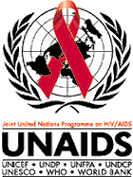
by: UNAIDS, WHO, and UNESCO
Handbook for Curriculum Planners
Teacher's Guide
Students' Activities
Handbook
for Curriculum Planners
Unit
A: Designing the programme
Unit B: Sample
materials for introducing the curriculum and for teacher training
Unit C:
Programme evaluation instruments
Teacher's
Guide
Unit 1 : Basic knowledge
on HIV/AIDS/STD
Unit 2 : Responsible behaviour:
delaying sex
Unit 3 : Responsible behaviour:
protected sex
Unit 4 : Care and support
Students'
Activities
Introduction:
Table of content
Unit 1: Basic knowledge of HIV/AIDS/STD
Unit 2: Responsible behaviour:
delaying sex
Unit 3 : Responsible behaviour:
protected sex
Unit 4: Care and support for people with HIV/AIDS
The goal of AIDS education is to promote behaviour that prevents the transmission of HIV/STD. Learning the behavioural skills that are needed for prevention forms the major content of this curriculum. The programme is based on the observation that biomedical information on the disease is not enough to convince people, including young people, to adopt healthy behaviour that prevents HIV/STD. What is needed is the motivation to act and skills to translate knowledge into practice.
This prototype resource package has been published to assist curriculum planners to design HIV/AIDS/STD education programmes for their own school systems, for students aged between 12 and 16. The programme presented in this package is based on participatory methods, as these have been shown to be particularly effective for the teaching of behavioural skills.
The package
includes :
• Handbook for curriculum planners: Outlines the main steps
in curriculum planning, and includes a series of appendices, mostly evaluation
instruments.
• Teachers’ guide: Contains specific instruction on how to teach each activity, and background information for teaching a programme on HIV/AIDS/STD. This guide may also be adapted for language, content, and teaching methods.
• Students’ activities: Includes fifty-three student activities that meet a wide range of objectives for teaching an HIV/AIDS/STD programme. Curriculum planners may choose those most relevant to their country, and adapt the text and the illustrations for language and content, according to the cultural context and the age of students targeted.
Handbook for Curriculum Planners
There
is increasing consensus about the need for AIDS education for young people.
Studies have shown that sex and AIDS education may lead to a delay in
the onset of sexual activity, and to the use of safer sex practices among
those students who are sexually active. However, curriculum planners often
lack examples of curricula, classroom activities and learning materials.
This resource package has been compiled to assist curriculum planners
to design HIV/AIDS/STD education programmes for their own school systems,
for students aged between 12 and 16. The programme presented in this package
is based on participatory methods, as these have been shown to be particularly
effective for the teaching of behavioural skills.
Introduction:
Table of content
Unit A: Designing the
programme
Unit B: Sample
materials for introducing the curriculum and for teacher training
Unit C:
Programme evaluation instruments
Teacher's
Guide
This
guide has been developed to help teachers prepare and teach a programme
on AIDS.
For each student activity suggested for use in your classroom, there is
guidance on:
• How to do that activity; answers to the questions or activities;
• Special concerns about the activity (if applicable);
• Use of peer leaders; parent involvement;
• Additional information or preparation teachers might need.
Introduction
The programme ; teaching methods ; the classroom atmosphere ; peer leaders
; participation of parents and family members ; test items for student
evaluation ; questions on HIV/AIDS/STD.
Unit
1 : Basic knowledge on HIV/AIDS/STD
Unit 2 : Responsible behaviour:
delaying sex
Unit 3 : Responsible behaviour:
protected sex
Unit 4 : Care and support
Students'
Activities
Infection
with HIV/STD occurs in specific risk situations or scenarios: a girl is
pressured by her boyfriend into having sex, [...give examples from the
situation assessment study]. Young people in these situations need to
have the knowledge and skills to respond adequately, for example, how
to say “no” or how to propose alternatives.
Through the achievement of a set of learning objectives, the curriculum aims to increase knowledge and to develop skills, positive attitudes and motivation.
Introduction:
Table of content
Unit 1: Basic knowledge of HIV/AIDS/STD
This unit presents the basic information on HIV, AIDS, STD; how HIV/STD are transmitted; how they are not transmitted; methods of protection from HIV/STD; difference between HIV and AIDS; sources of help. Note that this unit takes about 25% of the curriculum. Objectives [...] are covered in this unit.
Unit 2: Responsible behaviour: delaying sex
Students, particularly at early ages, should be encouraged not to have sexual intercourse. Delaying sex to an older age usually results in more mature decisions about contraception and protected sex. Students need to discuss the reasons and supports for delaying sexual intercourse, and learn how to resist pressures for unwanted sex. Assertive communication skills should be learned through role-play of real-life situations that young people may encounter. They may also learn that affection can be shown in ways other than sexual intercourse.
Unit 3 : Responsible behaviour:
protected sex
Some, perhaps many students may already be sexually active at the time they learn about AIDS in this programme. Others will need to know how to protect themselves in the future, when they will be sexually active. Using a condom every time one has sexual intercourse is a very effective way to avoid infection with HIV/STD. Teaching students about condoms does not mean encouraging them to have sex; young people are exposed to information about condoms through a variety of sources (friends, media, condoms displayed in shops, etc.), and need to have information and skills on how to use condoms correctly.
Unit 4: Care and support for people with HIV/AIDS
Many young
people will come in contact with people with HIV and AIDS, perhaps in
their own family and community.
They need to learn tolerance, compassion, and ways to care for and support
these people. Unit 4 covers objectives [...] and will take approximately
25% of the programme.

